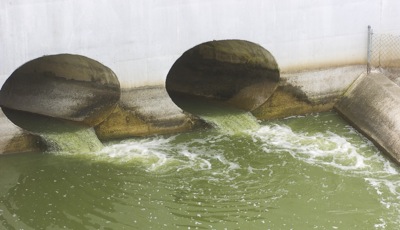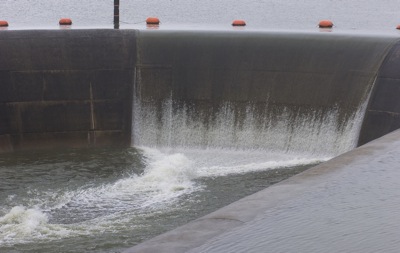Saturday, January 14th, 2012
State may be ready to allow lake water out
By Nancy Allen

Photo by Mark Pummell/The Daily Standard
Two tubes near the base of the spillway draw water from the lake into Beaver Creek. Several landowners blame increased flooding on the 500-foot West Bank Spillway built in 1997 that replaced the original 39-foot spillway built in 1913. State officials are considering how to manage the lake's water level.
GRAND LAKE - The state is reassessing how it manages the water level in Grand Lake following a third flooding lawsuit won by area landowners.
Ohio Department of Natural Resources (ODNR) officials said no decision would be made on managing the lake's level while the lawsuits were pending. It now appears they are ready to start talking.
Lake level management will be among many topics discussed at a meeting Wednesday between state officials and members of the local Lake Restoration Commission (LRC) trying to solve the lake's toxic algae problems.
ODNR spokesman Carlo Loparo would not discuss the issue with the newspaper other than to say the state would have more information after the meeting.
The most recent lawsuit concluded Dec. 1 when the Ohio Supreme Court sided with 85 landowners who blame increased flooding on their land on the West Bank Spillway. The landowners have yet to be awarded compensation in what is likely the largest eminent domain case in the state's history, said the landowners' attorney Bruce Ingram.
Overflow water exits the 13,500-acre lake via the spillway into Beaver Creek and then into the Wabash River. The 500-foot spillway built in 1997 replaced the original 39-foot spillway built in 1913. After the new spillway was built, the state discontinued a lake drawdown policy, court documents state, deeming the new spillway self regulating of the lake's water level. The new spillway has two tubes near its base that can be opened to draw water from the lake into Beaver Creek.
In 2005, five farmers won the first lawsuit and eventually were awarded $5.6 million for their flood-damaged land. A few years prior, the farmers asked the Mercer County Soil and Water Conservation District (SWCD) to write a letter to ODNR asking it to reinstitute its policy to drawdown the lake during winter months.
"We did send a letter to ODNR asking the state to manage it in a way that the lake would be able to accept more rain in the spring," SWCD administrator Nikki Hawk said. "As a general rule, the (SWCD) board has wanted the lake level managed such that it would be dropped down to be even with the spillway notch (normal pool) in the fall and winter."
The state last year also lost a case involving the owner of a Celina fitness facility. He won $3.3 million in compensation for flood damages the facility sustained in 2003.
After the Supreme Court ruling, ODNR spokeswoman Laura Jones said she was unsure if the state had a "set (lake drawdown) policy." She also said the state intended to look at all aspects that would bring the state closer to looking at the overall management of the lake level.
One lake official said he empathizes with landowners but is not sure there is a remedy because Mother Nature is unpredictable.
"It's one of those situations where you're damned if you do and you're damned if you don't, and we clearly realize it," LRC member Milt Miller said. "It makes sense to draw it down to create capacity, but if you don't get spring rains, our (lake) tourism goes into the tank."
Donna and Terry Temple, who own Sunnyside Inn on the lake's south side, had differing opinions on action needed.
"It would be a gamble; would we get rain or not," said Donna Temple. "If the lake gets too low in the fall it would take the boating season out. That would definitely hurt our business."
"The way things are going they got to do it (lower the lake) because of the rainfall we've had," said Terry Temple, who added he fears more lawsuits would be filed against the state if the lake level isn't lowered. "It will help, but I hope it don't hurt us in the summer."

Photo by Mark Pummell/The Daily Standard
Several landowners blame increased flooding on the 500-foot West Bank Spillway built in 1997 that replaced the original 39-foot spillway built in 1913. State officials are considering how to manage the lake's water level.





